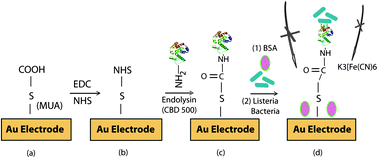By Polly-Anna Ashford, Web Writer
First discovered in the 1920s, Listeria remains a prolific food and water borne bacteria with a significant mortality rate. Scientists led by Mohammed Zourob at the National Institute of Scientific Research (INRS), Quebec, in collaboration with ETH Zürich, have developed a new screen printed gold electrode for the specific detection of Listeria via electrochemical impedance spectroscopy (EIS). Current methods of detection using culturing techniques are time-consuming and difficult to automate. In this Analyst paper, the authors report the immobilisation of endolysin protein onto a gold surface, which is characterised and monitored using the simple, low cost EIS technique. This method allows the rapid detection of Listeria in either pure culture or samples of artificially contaminated milk.
A bacteriophage endolysin-based electrochemical impedance biosensor for the rapid detection of Listeria cells
Mona Tolba, Minhaz Uddin Ahmed, Chaker Tlili, Fritz Eichenseher, Martin J. Loessner and Mohammed Zourob
Analyst, 2012, Advance Article
DOI: 10.1039/C2AN35988J











